|
TennisOne Lessons Use Your Opposite Hand to Improve Your Tennis Game One of my students once asked me, "Of all the teaching concepts you use, which one has been the most popular over the years?" Great question; easy answer...How to use your opposite hand when playing tennis! Groundstrokes, serving, returning serve and the volley...Knowing how to use your opposite hand will improve these strokes!
How to Position Your Opposite Hand on the Racquet Lets assume you are in the basic "ready position" waiting for either a groundstroke or to return serve. Your dominant hand rests on the grip. Your opposite hand should be positioned with the tip of the index finger touching the strings while the tips of the thumb and other 3 fingers cradle the racquet. Now you are ready to begin using your opposite hand to improve your tennis game! Main Functions of Using the Opposite Hand
Lets take a look at each of these functions: To Change the Grip Instead of your hitting hand flying all over the grip which creates fatigue, simply let that hand relax while you turn the racquet with your opposite hand to find the different grips you use. In just a few minutes you will notice how you can "feel" where the grip is you desire. This will then allow you to focus on the court, the ball, and your opponent and not have to think about a "grip change."
To Rest Your Hitting Hand You only need a firm grip right before the moment of contact, during contact, and a little bit afterwards and even then, a "death grip" is not necessary. The rest of time, either between shots or while you are waiting for the next point to begin, let your hitting hand relax while you hold the racquet in your opposite hand. Squeezing hard all the time makes for a weary hand, wrist, and arm! To Keep Your Racquet Head Up This relates to the point just noted about resting your hitting hand. Rather than hold the racquet up with your hitting hand, let your opposite hand do that task! Try walking around your house holding your racquet up with only your hitting hand for about 30 minutes and you will "feel" the point I am making here! To Guide and Prepare the Racquet Often my students will ask me which of the four functions are the most important. All of them are important but which one is a top priority for you may depend on your needs. Sometimes I have found just having a student relax their hitting hand makes a big difference. However, not everyone needs to relax their hitting hand or change grips, but all players have to guide and prepare the racquet! Instead of saying "racquet back," I tell my students, "Prepare the racquet with your opposite hand and then swing the racquet with your hitting hand. Let the two hands work together to control the racquet ." Following are answers to the most frequently asked questions related to guiding and preparing the racquet:
A. Why Does The Index Finger Need To Touch The Strings? The strings are what is going to make contact with the ball. By having your index finger on the strings you can feel where there racquet head is during preparation. When you prepare the racquet you are going to lose visual contact with the strings and therefore your index finger becomes your "third eye" so you will always be aware of the location of the racquet head. Note on the forehand groundstroke: Let your own comfort level determine how long you keep your opposite hand on the racquet during the preparation. B. How Does Using The Opposite Hand Help Me Correct My Errors? This may be the most important feature of using your opposite hand, particularly for groundstrokes and returning serve! When you make contact with the ball there are only 4 mistakes you make!? Into the net, long and wide either to the left or right! Around 90% of the errors, at all levels either hit the net or go long. So use your opposite hand to change the angle of the racquet face to correct mistakes i.e., if you hit the ball into the net, open the racquet face up; if you hit the ball long, close the racquet face. Instantly you can begin to correct 90% of your hitting errors by using your opposite hand! Many people believe the swing is the most important part of a stroke and that may be one of the biggest misunderstandings in tennis. It is the contact, when the ball and strings meet, which determines the result more than any other factor. For example, you can turn sideways, bend your knees, take your racquet back, and follow-through perfectly on every forehand; but if your racquet face is always closed at the moment of contact, the ball is going into the net every time! C. How Can Players Who Hit A Two-Handed Backhand Use The Opposite Hand?
My recommendation, and what the overwhelming majority of my students have found to work best for them, is to begin to prepare the racquet like you are going to hit a one-handed backhand and then when it is comfortable for you in terms of timing, slide your opposite hand down so both hands are on the grip This way you incorporate the benefits of a one-handed shot. You are still able to let your hitting hand relax and you are able to set the racquet face at the angle you desire before moving your hand down to the grip. Usually 3-5 minutes of tossing, feeding, and hitting balls is all it takes for a two-handed player to incorporate using the opposite hand on their backhand. It has more to do with making it a "habit" rather than "timing." It is very important to remember that players with a one-handed backhand rarely ever have to hit a two-handed shot; but players with a two-handed backhand sometimes have to hit a one handed shot i.e., when they are forced out wide on a return of serve or stretched wide for a groundstroke. For those two-handed players who feel "weak" when they are forced to hit a one-handed groundstroke or volley, using their opposite hand will immediately make the racquet head feel more stable and secure. I always encourage every player who has a two-handed backhand to spend some time working on their one-handed shot, because they are going to be forced to use it at some point during a match.
Using the Opposite Hand for Other Strokes The Volley - In addition to the information noted above, an added benefit applies to anyone who has problems with taking too big of racquet preparation and therefore ends up hitting their volleys late. If you let the opposite hand "set up" the racquet head for a volley you will almost automatically keep your hands and racquet out in front of you and eliminate late hits. This also works the same for returning serve! The Serve - Put the ball between your thumb and index finger and let the racquet, right around the throat area, rest on your remaining three fingers...This will immediately support the racquet head and allow you to relax your hitting hand! By giving your opposite a hand a "function" you will quickly improve your tennis game! Your comments are welcome. Let us know what you think about Dave Kensler's article by emailing us here at TennisOne.
Dave Kensler has been teaching tennis for 23 years with Peter Burwash International(PBI). PBI contracts with resorts, hotels and clubs all over the world to direct tennis programs. The company presently has professionals working at 62 facilities in North America, Europe, Asia, Middle East, Caribbean, Pacific and Indian Ocean. During its 30 years in business, PBI tennis professionals have taught tennis in over 135 countries. For more information visit: www.pbitennis.com. |

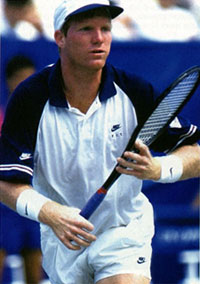
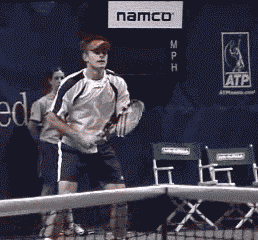
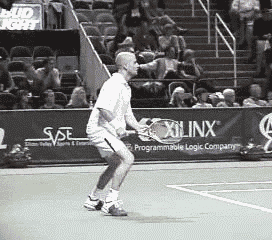
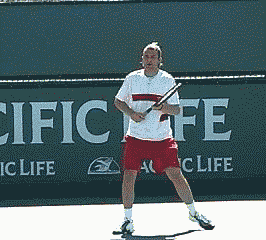
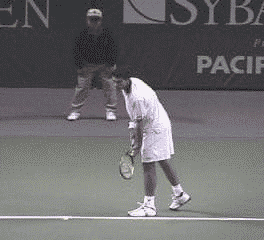 Mark Philippoussis uses his opposite hand to support the racquet on the serve.
Mark Philippoussis uses his opposite hand to support the racquet on the serve.